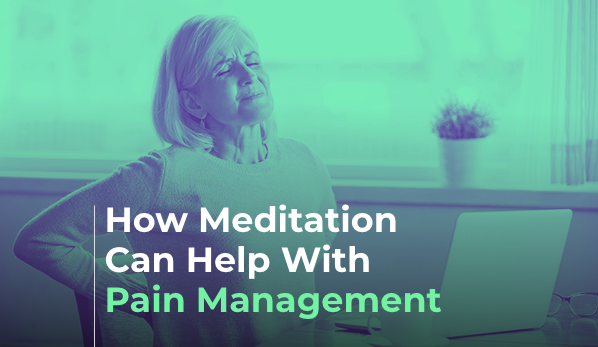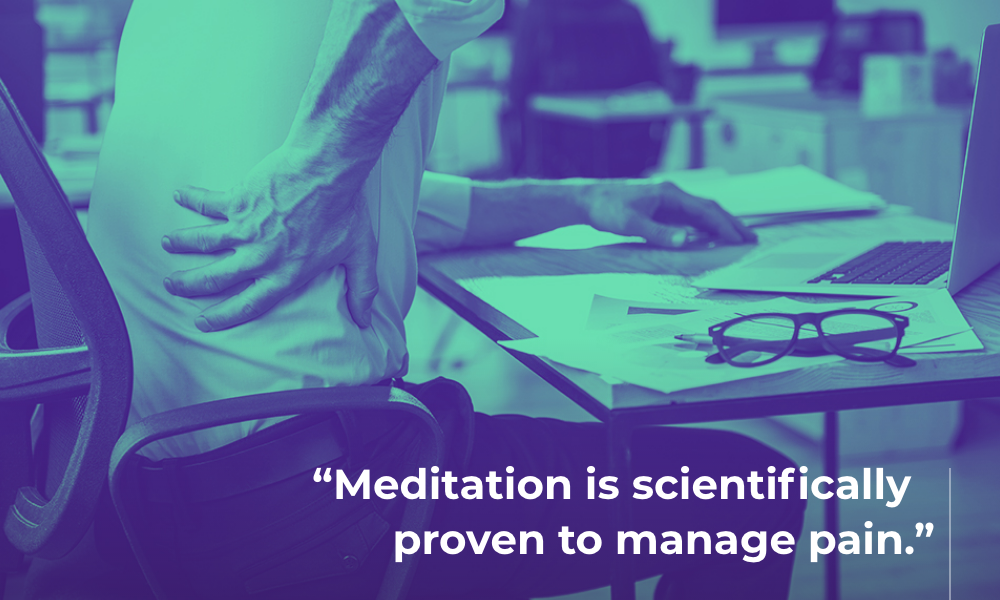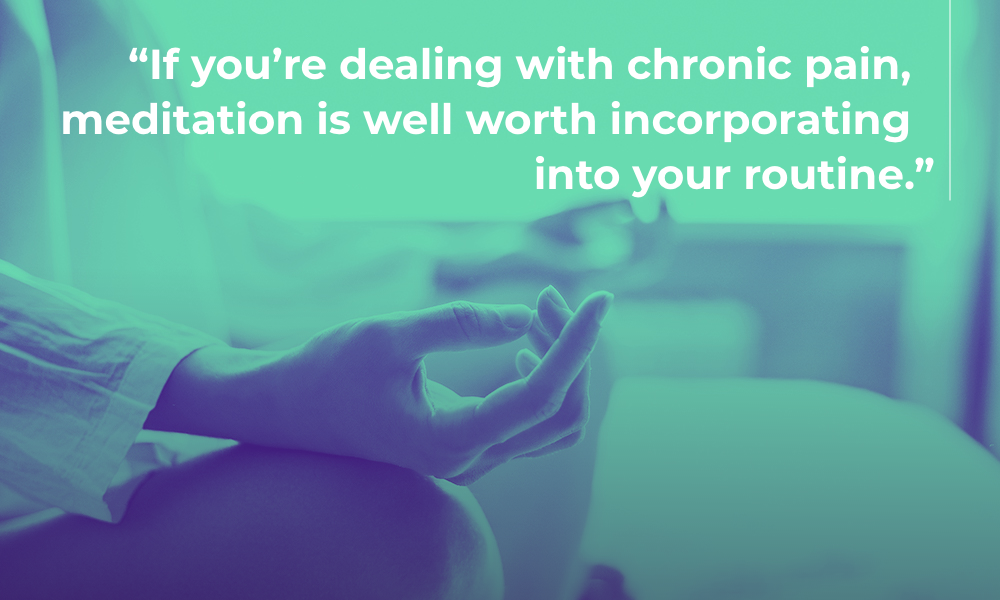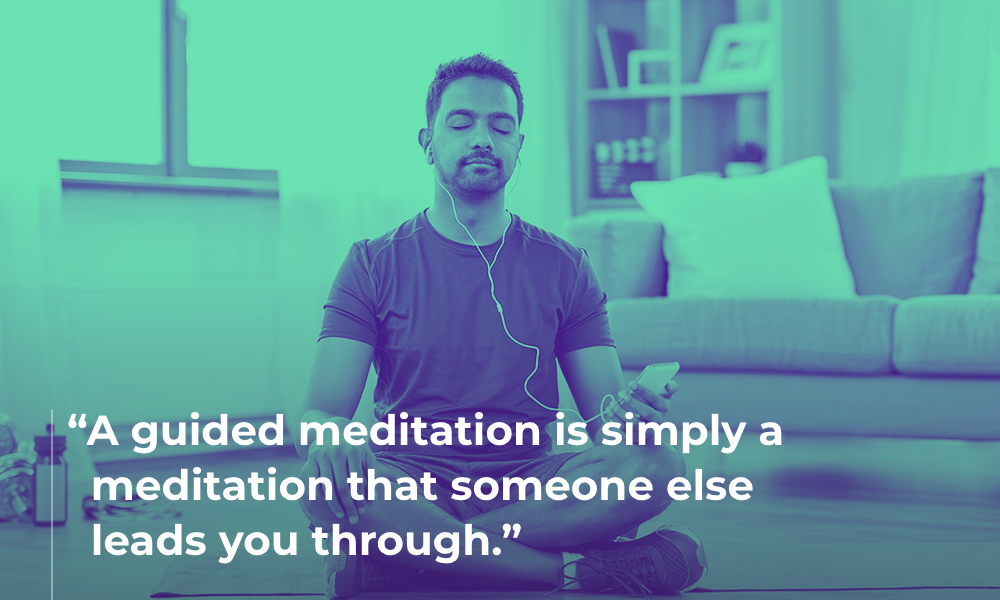If you’re suffering from a temporary injury or chronic pain conditions, like low back pain or fibromyalgia, we have good news. Meditation can help with pain management! Meditation helps by centering you in the present moment, allowing your body to let go of tension, and activating the feel-good chemicals in your brain. In this way, meditation can make a surprising impact on your physical pain management routine.
In this article, we’ll take a look at meditation for pain relief and discuss the scientific findings that support meditation as a pain treatment. We’ll explore treating pain with meditation vs using narcotics to relieve pain, and we’ll examine how guided meditation can be especially useful for helping you find some pain relief. Finally, we’ll tell you exactly how to start meditating to ease pain and get relief today. Let’s dive in!
Meditation to Relieve Pain
Meditation is scientifically proven to manage pain. And, sometimes, pain meditation can relieve pain entirely rather than just helping to manage it.
Whether meditation can relieve your pain entirely depends on many factors, like the severity and cause of your pain.
In some cases, your brain gets stuck in a “feedback loop” that leads us to suffer from pain well after the injury has healed. In these cases, it’s your mind that needs healing more than your body, and this is where meditation to relieve pain can make a monumental difference.
Regardless, it’s best not to go into meditation with any expectations about how much pain relief you will experience. Instead, you’ll get the best results when you focus your attention on the practice itself. In fact, whether you’re meditating to get full pain relief or to manage a chronic condition, your meditation practice will look, more or less, the same.
As counter-intuitive as it may seem, pain relief meditation will ask you to accept and explore your pain, rather than to ignore it or push it away. Just like naming an emotion can decrease its power, feeling into a sensation of pain can decrease its intensity.
Scientific Facts About Meditation for Pain Relief
It’s not all in your head. Studies show that meditation for pain relief really does work. In fact, one experiment found that mindfulness meditation “reliably alleviates experimentally induced and clinical pain”— even after just 10 hours total of meditation practice.
Another study found that meditation activates your body’s own opioid system, helping to lessen feelings of pain. An additional study in which participants were given electric shocks found that the participants who meditated had 22% less pain and 29% less anxiety about anticipating the pain than their counterparts who didn’t meditate.
Meanwhile, a study of those with chronic back pain found that those who meditated reduced their pain by over 30%. Finally, a review of studies found that regular meditators have less pain sensitivity than their peers who don’t meditate regularly. The review also found studies that support meditation for chronic pain, citing pain relief for fibromyalgia pain, migraine pain, chronic pelvic pain, and low back pain.
Meditation vs. Narcotics for Pain Management
If you’ve experienced an injury or suffer from chronic pain, you’ve likely been prescribed narcotics to manage the pain. There’s nothing inherently “wrong” with that. What’s best for your body is up to you and your healthcare professional.
That said, there’s no doubt that narcotic use is spiraling out of control in the United States. According to the U.S. Department of Health and Human Services (HHS), almost 10 million people misused prescription pain relievers in 2019. The HHS also notes that about 67% of 2018 deaths from drug overdoses came from opioids.
To put it simply, opioids are addictive and can come with undesirable side effects. That’s why it’s wise to explore alternatives, if you can.
Mindfulness-based treatments (MBTs) are some of the most frequently recommended alternative pain management techniques.
As we’ve already discussed, meditation is scientifically proven to reduce pain. And a 2019 meta-analysis of studies by the American Medical Association found that it also corresponds to a decrease in opioid use. That’s right, meditation for pain management is so effective that it correlates with a drop in opioid use. If you use narcotics to manage pain, meditation may be able to help you ease off of them (or lower your dose). However, it’s critical to speak with your healthcare professional before making any changes to your health and wellness routine.
Meditation and Chronic Pain
If you’re dealing with chronic pain, meditation is well worth incorporating into your routine. It’s important to understand that multiple factors influence pain. The nagging ache you feel in your back, for example, isn’t solely due to musculoskeletal issues. There are also environmental, mental, and emotional factors at play that influence your experience of the pain. This is true for all types of pain, but especially for chronic pain.
In other words, chronic pain has a lot of sources. And the good news is meditation can help address many of them—namely the mental and emotional ones. One way meditation works for chronic pain is by promoting stress relief—pain and stress work in a vicious cycle, each triggering the other in turn. Meditation can not only help to reduce feelings of stress, but it can reduce the inflammatory response caused by stress, which is a leading aggravator of pain.
Moreover, pain meditation techniques help you detach from thoughts about your chronic pain. In many cases, the thoughts can be as unpleasant as the pain itself. Plus, they can actively perpetuate feelings of pain—even after an injury has healed. Meditation helps you objectively label your pain for what it is rather than assign judgment to it. This can take away some of the pain’s emotional power. Plus, meditation activates endorphins—your body’s feel-good hormones—which are up to 100 times stronger than morphine!
Guided Meditation for Chronic Pain
Nearly any type of meditation can benefit chronic pain. However, if you’re new to meditation, or if you want to specifically use meditation for chronic pain relief, we recommend trying a guided pain management meditation.
A guided meditation is simply a meditation that someone else leads you through. The leader can be an in-person meditation teacher, a guided meditation video, recording, or a meditation app. A guided pain relief meditation is a great choice for those suffering from chronic pain for several reasons:
- A guided meditation helps you stay focused. If you’re suffering from pain, it’s easy for your thoughts to drift from your meditation practice to the unpleasant sensations you’re experiencing. Because a guided meditation for pain typically reminds you to return to your breath, it can help you get back on track.
- A guided healing meditation keeps you in a routine. Meditation works best when you make it a regular part of your routine. But sometimes it can be hard to practice consistently. Most guided meditation apps let you set reminders that help you return to your practice every day. Plus, they offer many different types of meditations to try, which can help you stay excited about your meditation practice.
- Guided meditations often include guided imagery, body scan, and other helpful techniques. When you use a guided meditation app, you can practice more than just following your breath. Many meditation apps use guided imagery (which has been shown to help reduce pain) and other techniques to enhance your meditation practice and help you reach your goals.
How to Start Meditating for Pain Relief or Management
If you’re dealing with pain—whether it’s temporary or chronic—don’t give up hope. Meditation is an accessible (you can even do it lying down!) and free alternative therapy that’s scientifically proven to make a difference in your pain, improve your mental health, elevate your quality of life, and help to heal your body. Even a 10-minute meditation each day can make a huge difference in your well-being.
Used in place of or as a complementary addition to prescription medication, a regular meditation practice can help you distance yourself from pain and release some of the fear and anxiety that surrounds it. Plus, you’ll reap the other benefits of meditation too, like reduced signs of aging, better sleep, better cognitive performance, improved focus, better memory, more productivity, and an improved immune system, to name a few.
Guided meditation is one of the best ways to get started with meditation to relieve pain, and Primed Mind is the best meditation app to use. Primed Mind was created by one of the world’s leading mindset coaches, who designed it to include hypnotic meditations tailored to help you meet specific goals.
Primed Mind features an easy-to-navigate menu of guided hypnotic meditations that are available to access as soon as you download the app for free. So, give it a try today and see the difference meditation can make for your chronic pain. Or, if you’d like to learn more about getting started with meditation before you download, read our article on how to meditate.




